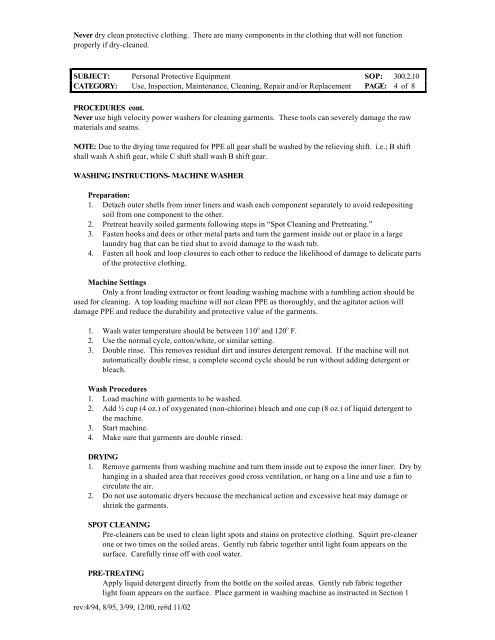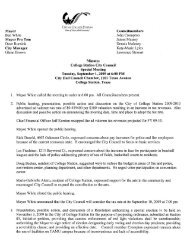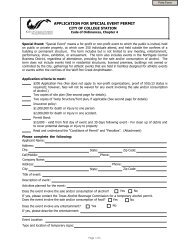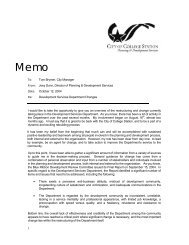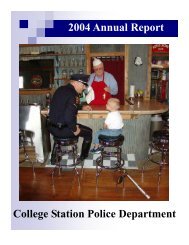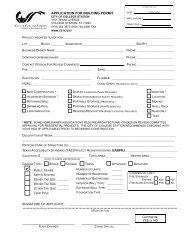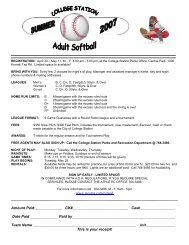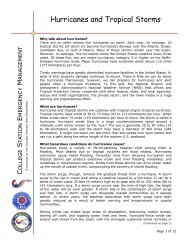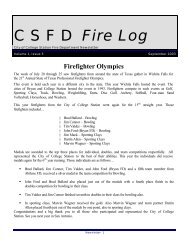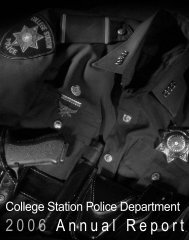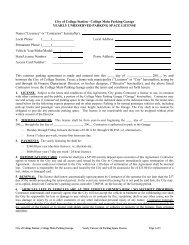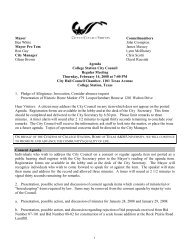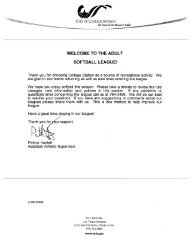standard operating procedure college station fire department
standard operating procedure college station fire department
standard operating procedure college station fire department
You also want an ePaper? Increase the reach of your titles
YUMPU automatically turns print PDFs into web optimized ePapers that Google loves.
Never dry clean protective clothing. There are many components in the clothing that will not function<br />
properly if dry-cleaned.<br />
SUBJECT: Personal Protective Equipment SOP: 300.2.10<br />
CATEGORY: Use, Inspection, Maintenance, Cleaning, Repair and/or Replacement PAGE: 4 of 8<br />
PROCEDURES cont.<br />
Never use high velocity power washers for cleaning garments. These tools can severely damage the raw<br />
materials and seams.<br />
NOTE: Due to the drying time required for PPE all gear shall be washed by the relieving shift. i.e.; B shift<br />
shall wash A shift gear, while C shift shall wash B shift gear.<br />
WASHING INSTRUCTIONS- MACHINE WASHER<br />
Preparation:<br />
1. Detach outer shells from inner liners and wash each component separately to avoid redepositing<br />
soil from one component to the other.<br />
2. Pretreat heavily soiled garments following steps in “Spot Cleaning and Pretreating.”<br />
3. Fasten hooks and dees or other metal parts and turn the garment inside out or place in a large<br />
laundry bag that can be tied shut to avoid damage to the wash tub.<br />
4. Fasten all hook and loop closures to each other to reduce the likelihood of damage to delicate parts<br />
of the protective clothing.<br />
Machine Settings<br />
Only a front loading extractor or front loading washing machine with a tumbling action should be<br />
used for cleaning. A top loading machine will not clean PPE as thoroughly, and the agitator action will<br />
damage PPE and reduce the durability and protective value of the garments.<br />
1. Wash water temperature should be between 110 o and 120 o F.<br />
2. Use the normal cycle, cotton/white, or similar setting.<br />
3. Double rinse. This removes residual dirt and insures detergent removal. If the machine will not<br />
automatically double rinse, a complete second cycle should be run without adding detergent or<br />
bleach.<br />
Wash Procedures<br />
1. Load machine with garments to be washed.<br />
2. Add ½ cup (4 oz.) of oxygenated (non-chlorine) bleach and one cup (8 oz.) of liquid detergent to<br />
the machine.<br />
3. Start machine.<br />
4. Make sure that garments are double rinsed.<br />
DRYING<br />
1. Remove garments from washing machine and turn them inside out to expose the inner liner. Dry by<br />
hanging in a shaded area that receives good cross ventilation, or hang on a line and use a fan to<br />
circulate the air.<br />
2. Do not use automatic dryers because the mechanical action and excessive heat may damage or<br />
shrink the garments.<br />
SPOT CLEANING<br />
Pre-cleaners can be used to clean light spots and stains on protective clothing. Squirt pre-cleaner<br />
one or two times on the soiled areas. Gently rub fabric together until light foam appears on the<br />
surface. Carefully rinse off with cool water.<br />
PRE-TREATING<br />
Apply liquid detergent directly from the bottle on the soiled areas. Gently rub fabric together<br />
light foam appears on the surface. Place garment in washing machine as instructed in Section 1<br />
rev:4/94, 8/95, 3/99, 12/00, re#d 11/02


